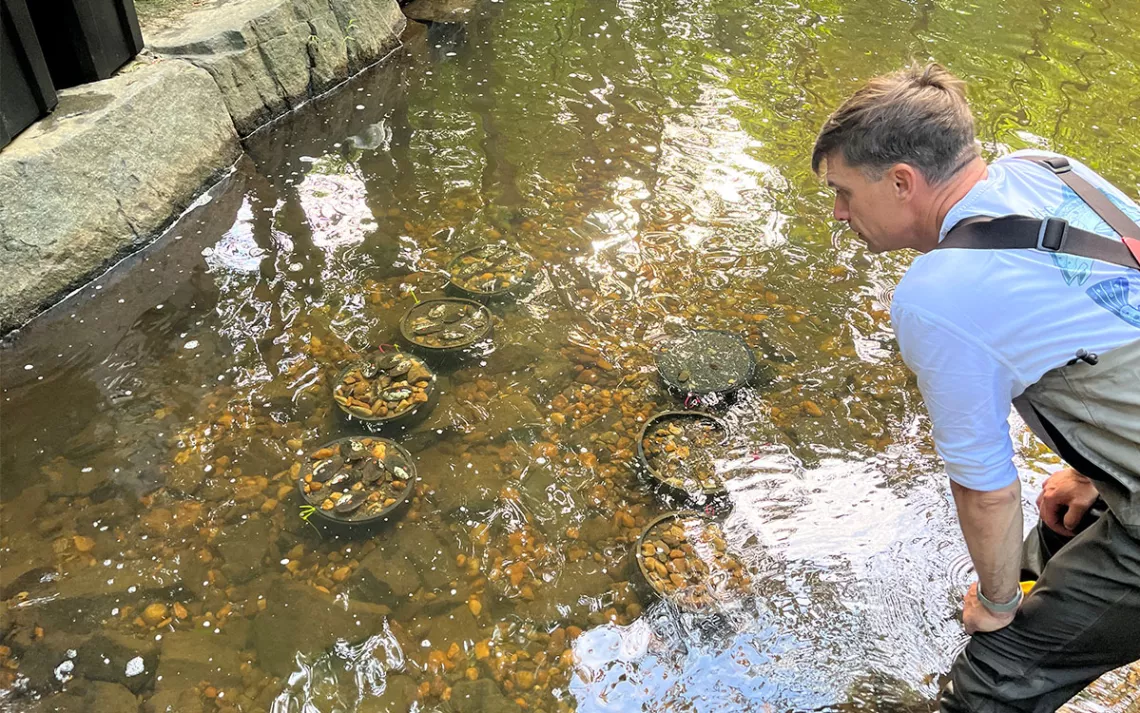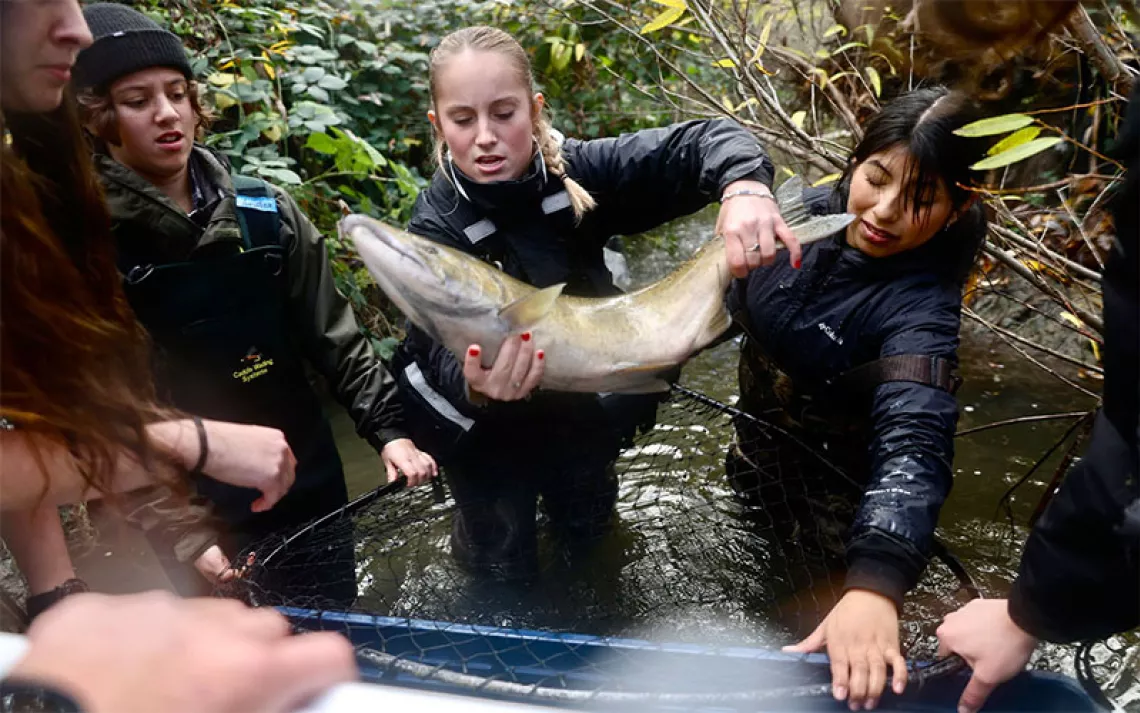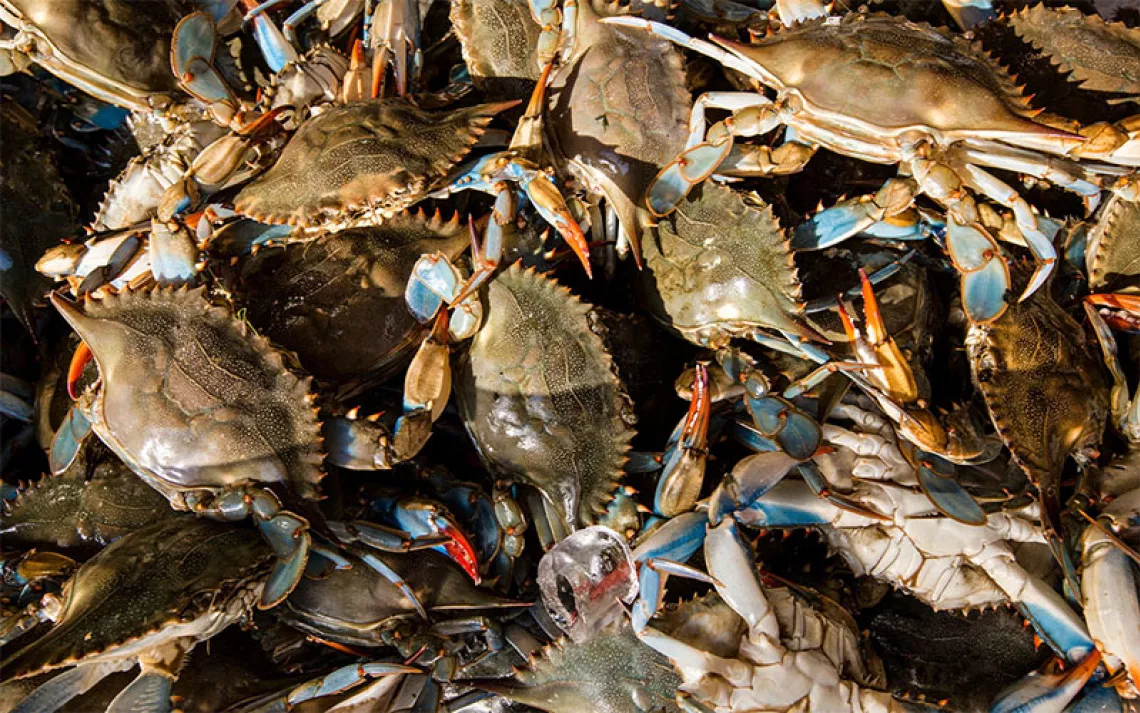Could a Little Bit of Mussel Fix Our Polluted Streams?
Researchers enlist native species to help restore degraded streambeds in Northern Virginia

A researcher inspects buckets of freshwater mussels waiting to be released into their new home. | Photo courtesy of Ashley L. Conti and Colby University
With rubber boots barely making it past the top of the water surface, aquatic ecologist Denise Bruesewitz crouched over a small dip in the water, dumping an onion sack of rock-like creatures into the streambed. She thinks that the inconspicuous, unremarkable river mollusks she’s releasing could stop North America’s freshwater ecosystems from rapidly degrading.
“They're one of my very favorite animals,” Bruesewitz, a professor of environmental studies at Colby College, said. “They're fascinating. They're beautiful. But you know, they're kind of invisible.”
As factories, farms, malls, golf courses, and highways have cropped up over the decades, North America’s growing urban landscape has increasingly encroached on its watercourses, slimming down its streams and eroding its riverbanks.
Because of this, instead of gradually percolating through the soil for microbes and roots to lap up and slowly disperse, when rain falls down now, it hits the stiffer, harder ground, inundating the watershed in what scientists call "flashes." These flashes sweep up fertilizers, pesticides, debris, sediment, and bacteria and dump them into the water unfiltered, decimating many of the delicate marine ecosystems.
The pollutants ultimately trickle down the network of creeks and end up pooled in estuaries where freshwater meets the ocean. This can release agricultural runoff into the water, causing unnaturally high levels of algae blooms, reducing oxygen levels. A classic case can be seen in the Chesapeake Bay, the largest estuary in the United States. (The Chesapeake Bay Foundation has given the bay a D-plus rating for environmental health multiple years in a row.)
To counter this, several local organizations have spent the last 15 years physically restoring the streams that lead to the bay, introducing extra boulders and cobblestone to prevent erosion, a first step toward restoring riverine ecosystems. But a team led by Bruesewitz thinks it's crucial to also focus on the chemical aspect of restoring these streams: getting rid of the pollution they’ve absorbed by calling on a little help from the stream’s native freshwater mussels.
These huge bivalves are like nature’s very own Brita filter. When feeding, they can filter up to 15 gallons of water a day, absorbing bacteria and contaminants from the water column, metabolizing some of them, and leaving the rest as poop for microbes in the sediment to break down. They are major ecosystem engineers, and they are specially built—a “magic bullet”—for siphoning the extra nitrogen in water, which begets toxic algal blooms, says Bruesewitz.
Although the southeastern US is already a hot spot for freshwater mussels and home to more than 270 species of these bivalve mollusks, they have faced a myriad of threats. Habitat fragmentation, excessive pollution, and the button industry, which led people to harvest mussels for shiny buttons on an industrial scale in the 19th century, turned these invertebrates into one of the planet’s most endangered organisms. The legacy of such pressure still exists today, and approximately 65 percent of the nation’s mussel species are threatened, and 30 of them have already been declared extinct.
So, last summer, Bruesewitz’s team selected two physically restored rivers in a suburban area of Reston, Virginia—roughly 20 miles west of Washington, DC—and manually reintroduced 1,500 adult Eastern elliptio in both rivers, each mussel plucked from nearby waterways. This builds on research from 2019 when a team of scientists stocked a couple hundred mussels in cage-like enclosures to test out whether they could survive in restored streams.
“We picked about six different pools in each of the streams, and then we literally just chuck them in the water,” says Bruesewitz. They wanted to give them “flexibility to find the spot where they were happiest.” The Eastern elliptio is abundant throughout North America and is the size of a soda can, making it a good first choice to test filter feeding capacity.
“The advantage of the adults from the wild is they're fully grown, and they've experienced the full complement of conditions,” says Jess Jones, a restoration biologist at Virginia Tech who collaborated on this project. In Jones’s 20 years working on projects like these, his research suggests juvenile mussels would be less likely to survive.
The aim is to introduce 35,000 mussels from six different species—including creeper and triangle floater—in the next five years. An assemblage of mussels is helpful because they might filter out different parts of the water column, burrow to different depths, and be more active at different times of the year, therefore providing more filtration power.
Since the first introduction, Brusewitz and Jones have been going back to check in on the mollusks at monthly intervals. So far, the new residents seem to be doing just fine: They are burrowing, moving around, making snake-like trails in the sediment, and keeping their valves open for filtration. As of June 2024, the mussels have had a 98.2 percent survival rate in their new digs.

Sign up to receive Sierra News & Views
Get articles like this one sent directly to your inbox weekly.
With this action you affirm you want to receive Sierra Club communications and may vote on policy designated by the Sierra Club Board.
Since most of what researchers know about mussels is theoretical and complicated to test in the wild, this project is a “pretty neat idea,” according to Chris Eads, a freshwater mussel specialist at North Carolina State University, who is not involved in the project. “I think it's a really good test case for ‘Is this going to work?’”
One of the doubts about whether this project will succeed is that it’s still unclear whether the mussels will live long, healthy lives, and be able to reproduce, given their peculiar sex lives. When freshwater mussels get pregnant, they make millions of miniature larvae called glochidia and sneak them into the gills and fins of fish. Different species have different, creative tricks to pull this off, and each mussel species has a preferred set of host fish to parasitize.
The Eastern elliptio dupes its preferred hosts—the American eel, yellow perch, lake trout, and mottled sculpin, among others—by releasing a mucus net of glochidia for it to get tangled in. But Brusewitz and her team don’t know whether these specific host fish thrive in the streams where they released the mussels.
“This question of fish host species is actually really complicated and not fully understood,” says Bruesewitz, because it’s not set in stone which mussels need which host fish. If the host fish aren’t present in large enough numbers, the team will also get permits to translocate fish from nearby systems or breed them in the lab for repopulation. But this is still far down the line.
Given the growing number of projects focusing on oysters and mussels in marine ecosystems, it’s “really cool” to start thinking about how bivalves can make a difference upstream too, says Carla Atkinson, an aquatic ecologist at the University of Alabama, who was not involved in the study. One of the better-known projects for clearing up Chesapeake Bay’s pollution is the Oyster Recovery Partnership’s plan to replant 10 billion native oysters.
Still, this will be “a long-range project,” Atkinson said. “It's not like you just go put muscles out there and they're like, ‘Yeah, we're back. Things are great,’” she added. “You need to do it over and over and over before you're going to expect to get success. It's kind of like a decade-long process.”
For the upcoming months, Bruesewitz and her colleagues will keep an eye on the mussels and how they are impacting their ecosystems—what they are eating and pooping and whether levels of nitrogen and phosphorous have been significantly dropping. If this works, Bruesewitz hopes it could become a blueprint for restoration projects across the nation.
 The Magazine of The Sierra Club
The Magazine of The Sierra Club



